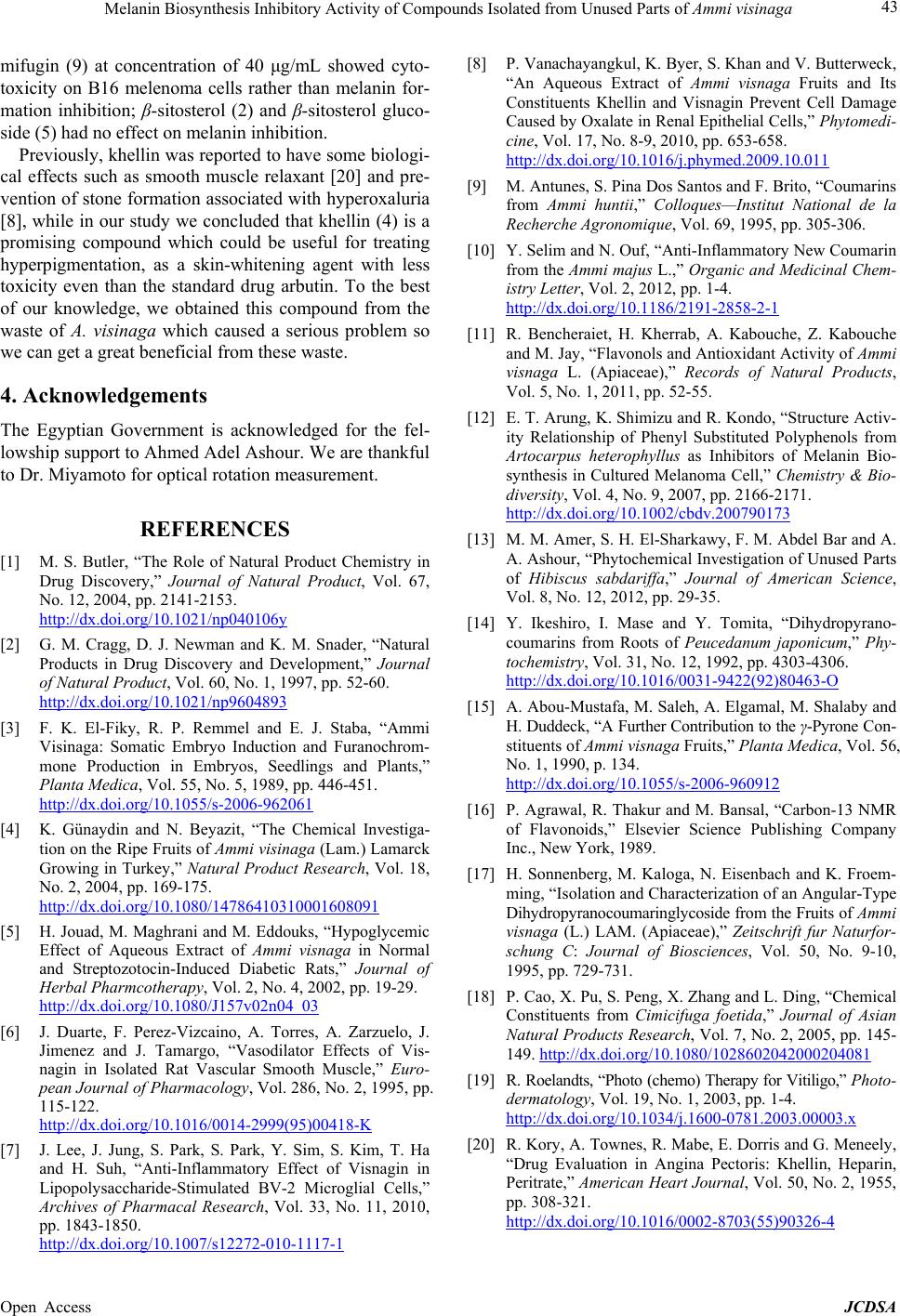
Melanin Biosynthesis Inhibitory Activity of Compounds Isolated from Unused Parts of Ammi visinaga 43
mifugin (9) at concentration of 40 μg/mL showed cyto-
toxicity on B16 melenoma cells rather than melanin for-
mation inhibition; β-sitosterol (2) and β-sitosterol gluco-
side (5) had no effect on melanin inhibition.
Previously, khellin was reported to have some biologi-
cal effects such as smooth muscle relaxant [20] and pre-
vention of stone formation associated with hyperoxaluria
[8], while in our study we concluded that khellin (4) is a
promising compound which could be useful for treating
hyperpigmentation, as a skin-whitening agent with less
toxicity even than the standard drug arbutin. To the best
of our knowledge, we obtained this compound from the
waste of A. visinaga which caused a serious problem so
we can get a great beneficial from these waste.
4. Acknowledgements
The Egyptian Government is acknowledged for the fel-
lowship support to Ahmed Adel Ashour. We are thankful
to Dr. Miyamoto for optical rotation measurement.
REFERENCES
[1] M. S. Butler, “The Role of Natural Product Chemistry in
Drug Discovery,” Journal of Natural Product, Vol. 67,
No. 12, 2004, pp. 2141-2153.
http://dx.doi.org/10.1021/np040106y
[2] G. M. Cragg, D. J. Newman and K. M. Snader, “Natural
Products in Drug Discovery and Development,” Journal
of Natural Product, Vol. 60, No. 1, 1997, pp. 52-60.
http://dx.doi.org/10.1021/np9604893
[3] F. K. El-Fiky, R. P. Remmel and E. J. Staba, “Ammi
Visinaga: Somatic Embryo Induction and Furanochrom-
mone Production in Embryos, Seedlings and Plants,”
Planta Medica, Vol. 55, No. 5, 1989, pp. 446-451.
http://dx.doi.org/10.1055/s-2006-962061
[4] K. Günaydin and N. Beyazit, “The Chemical Investiga-
tion on the Ripe Fruits of Ammi visinaga (Lam.) Lamarck
Growing in Turkey,” Natural Product Research, Vol. 18,
No. 2, 2004, pp. 169-175.
http://dx.doi.org/10.1080/14786410310001608091
[5] H. Jouad, M. Maghrani and M. Eddouks, “Hypoglycemic
Effect of Aqueous Extract of Ammi visnaga in Normal
and Streptozotocin-Induced Diabetic Rats,” Journal of
Herbal Pharmcotherapy, Vol. 2, No. 4, 2002, pp. 19-29.
http://dx.doi.org/10.1080/J157v02n04_03
[6] J. Duarte, F. Perez-Vizcaino, A. Torres, A. Zarzuelo, J.
Jimenez and J. Tamargo, “Vasodilator Effects of Vis-
nagin in Isolated Rat Vascular Smooth Muscle,” Euro-
pean Journal of Pharmacology, Vol. 286, No. 2, 1995, pp.
115-122.
http://dx.doi.org/10.1016/0014-2999(95)00418-K
[7] J. Lee, J. Jung, S. Park, S. Park, Y. Sim, S. Kim, T. Ha
and H. Suh, “Anti-Inflammatory Effect of Visnagin in
Lipopolysaccharide-Stimulated BV-2 Microglial Cells,”
Archives of Pharmacal Research, Vol. 33, No. 11, 2010,
pp. 1843-1850.
http://dx.doi.org/10.1007/s12272-010-1117-1
[8] P. Vanachayangkul, K. Byer, S. Khan and V. Butterweck,
“An Aqueous Extract of Ammi visnaga Fruits and Its
Constituents Khellin and Visnagin Prevent Cell Damage
Caused by Oxalate in Renal Epithelial Cells,” Phytomedi-
cine, Vol. 17, No. 8-9, 2010, pp. 653-658.
http://dx.doi.org/10.1016/j.phymed.2009.10.011
[9] M. Antunes, S. Pina Dos Santos and F. Brito, “Coumarins
from Ammi huntii,” Colloques—Institut National de la
Recherche Agronomique, Vol. 69, 1995, pp. 305-306.
[10] Y. Selim and N. Ouf, “Anti-Inflammatory New Coumarin
from the Ammi majus L.,” Organic and Medicinal Chem-
istry Letter, Vol. 2, 2012, pp. 1-4.
http://dx.doi.org/10.1186/2191-2858-2-1
[11] R. Bencheraiet, H. Kherrab, A. Kabouche, Z. Kabouche
and M. Jay, “Flavonols and Antioxidant Activity of Ammi
visnaga L. (Apiaceae),” Records of Natural Products,
Vol. 5, No. 1, 2011, pp. 52-55.
[12] E. T. Arung, K. Shimizu and R. Kondo, “Structure Activ-
ity Relationship of Phenyl Substituted Polyphenols from
Artocarpus heterophyllus as Inhibitors of Melanin Bio-
synthesis in Cultured Melanoma Cell,” Chemistry & Bio-
diversity, Vol. 4, No. 9, 2007, pp. 2166-2171.
http://dx.doi.org/10.1002/cbdv.200790173
[13] M. M. Amer, S. H. El-Sharkawy, F. M. Abdel Bar and A.
A. Ashour, “Phytochemical Investigation of Unused Parts
of Hibiscus sabdariffa,” Journal of American Science,
Vol. 8, No. 12, 2012, pp. 29-35.
[14] Y. Ikeshiro, I. Mase and Y. Tomita, “Dihydropyrano-
coumarins from Roots of Peucedanum japonicum,” Phy-
tochemistry, Vol. 31, No. 12, 1992, pp. 4303-4306.
http://dx.doi.org/10.1016/0031-9422(92)80463-O
[15] A. Abou-Mustafa, M. Saleh, A. Elgamal, M. Shalaby and
H. Duddeck, “A Further Contribution to the γ-Pyrone Con-
stituents of Ammi visnaga Fruits,” Planta Medica, Vol. 56,
No. 1, 1990, p. 134.
http://dx.doi.org/10.1055/s-2006-960912
[16] P. Agrawal, R. Thakur and M. Bansal, “Carbon-13 NMR
of Flavonoids,” Elsevier Science Publishing Company
Inc., New York, 1989.
[17] H. Sonnenberg, M. Kaloga, N. Eisenbach and K. Froem-
ming, “Isolation and Characterization of an Angular-Type
Dihydropyranocoumaringlycoside from the Fruits of Ammi
visnaga (L.) LAM. (Apiaceae),” Zeitschrift fur Naturfor-
schung C: Journal of Biosciences, Vol. 50, No. 9-10,
1995, pp. 729-731.
[18] P. Cao, X. Pu, S. Peng, X. Zhang and L. Ding, “Chemical
Constituents from Cimicifuga foetida,” Journal of Asian
Natural Products Research, Vol. 7, No. 2, 2005, pp. 145-
149. http://dx.doi.org/10.1080/1028602042000204081
[19] R. Roelandts, “Photo (chemo) Therapy for Vitiligo,” Photo-
dermatology, Vol. 19, No. 1, 2003, pp. 1-4.
http://dx.doi.org/10.1034/j.1600-0781.2003.00003.x
[20] R. Kory, A. Townes, R. Mabe, E. Dorris and G. Meneely,
“Drug Evaluation in Angina Pectoris: Khellin, Heparin,
Peritrate,” American Heart Journal, Vol. 50, No. 2, 1955,
pp. 308-321.
http://dx.doi.org/10.1016/0002-8703(55)90326-4
Open Access JCDSA